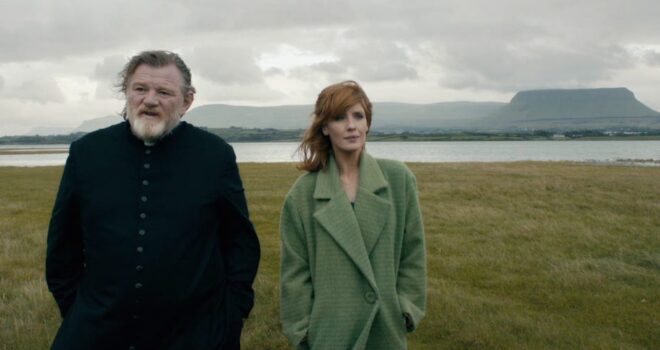A Commentary on Calvary: Forgiveness Unto Death
The central problem with our modern culture is apathy. We have lost our sense of direction culturally, politically and even within our own communities. It’s no wonder there is a mass crisis of faith. We are so unused to living for something beyond our noses that when faced with the prospect of God, we see a zero sum […]



The central problem with our modern culture is apathy. We have lost our sense of direction culturally, politically and even within our own communities. It’s no wonder there is a mass crisis of faith. We are so unused to living for something beyond our noses that when faced with the prospect of God, we see a zero sum game. We ask for God to prove Himself in our lives while making no effort to meet Him halfway.
The truth is, we aren’t asked to meet Him halfway; we are asked to drop everything and follow. The protagonist of John Michael McDonagh’s 2014 film Calvary is a previously married priest ministering to a small Irish town. The town, his flock, is dealing with both the Irish recession and the clerical scandal that devastated the Irish Catholic population. Everyone is weighed down by the world and has either given up on their faith or is actively in a crisis. The plot handles very mature themes and is not to be watched lightly.
The film kicks off with Brendan Gleeson’s extremely well-acted Father James being told in the confessional that he will be murdered in a week. The plot then follows the good priest’s journey both through the pastoral issues that plague his flock and his own acceptance of his cross. The whole film is a patient and poignant meditation on faith and what it means to be called.
Some reviews of this movie treat it as a simple whodunnit, but that is a gross reduction. The film is not about the threat of murder. It is simply about living, and trying to live well. Each character symbolizes one of the many modern misconceptions about religion, specifically Catholicism. There is a character who views it as simply restrictive for the sake of restriction, a character who clings to it out of fear, characters that are indifferent due to the harsh nature of life and so on. Each struggle of the members of Father James’ flock is considered, and at the end the antidote to modernity is revealed: forgiveness.
There is one character that breaks the mold of apathy that forms the topography of this story. There is the widow Teresa, who meets Father James after her husband was killed in a drunk driving accident. According to the framework used for characters thus far in the story, this is expected to be another example of how tragedy can shake even the most devout. But this couldn’t be further from the case. Teresa not only holds her faith despite the sudden tragedy, but she even gives Father James a heart-wrenching reminder of what having faith means.
There is a beautiful sequence in the hospital chapel, where Father James says, “In situations like this one, people are shocked. The randomness of it. They curse God. They curse their fellow man. They lose their faith in some cases.”
To which Teresa responds, “They lose their faith? It must not have been much of a faith to begin with.” As observed later in this scene, for most people, faith is simply fear of death, and they are only really concerned with temporal well being or pleasure.
Throughout the entire film, the characters struggle with this exact concept. “What is faith? And why have it?” is echoed by every character in some iteration—except Teresa, who understands that the events of your life are just what happens. Faith is what draws us out of the mire of the every day and puts us in contact with the divine.
This film makes no attempt to turn its protagonist priest into some superhero. It does not glamorize the narrow path of humility. It shows us that living is difficult and that there are a multitude of reasons people lose their faith. Yet, despite all the tragedies of life, the best possible outcome is when you live with integrity and humility and seek to forgive rather than punish.
Calvary is not just a whodunnit or a movie about faith and vocation. It is an all too human retelling of the universal fear of death. Save one, every character is in rebellion against mortality. Teresa, the widow with every right to rage against the unfair universe, takes the death of her husband not without grief and sorrow, but with grace and gratitude for the life she had lived. She is one of the few characters in modern cinema that has a pure faith. So many quasi-religious characters written by Hollywood are cowards who use the Bible as an excuse for their weakness and usually leave whatever poorly defined faith they practiced by the end of the plot. Calvary is an honest a look at humanity and its approach to faith. It shows that tragedy is one of the few unifying factors of the human experience. Even the title reinforces that whatever you go through, the only real way for your agony to matter is to give up yourself and follow in Our Lord’s steps.
Calvary is a film you could watch over and over and still leave with something new. I could write books on its symbolism and artistry, but if I could only say one praise to convince the reader to give it a watch, it would be this: Hollywood has spent years deconstructing faith with overblown acts of heroism and ego, and nothing it has produced compares to the silent, humble heroism found in Calvary. The antidote for modernity is not loud protests or calls to action. It is the virtue of forgiveness, even unto death.
Editor’s Note: This article is adapted from the author’s blog 100 Movies Every Catholic Should See.
Photo: McDonagh, J.M. (Director). (2014). Calvary [Film]. 20th Century Fox.














